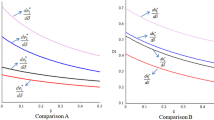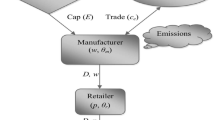Abstract
This paper considers a two-echelon green supply chain (SC) with one manufacturer that sells a same product to two retailers. There is also an environment-conscious government (Govt.) who intends to cooperate with the manufacturer and increase the level of the greenness of the products. We introduce a novel concept in the green literature which is to consider a dominant retailer in the green market. Then, we develop four scenarios for different power structures among the retailers and also for Govt. cooperation with the manufacturer and we obtain closed form solutions for the decision variables of the members based on game theory. By conducting a sensitivity analysis, the effects of power imbalance of the retailers in the market on the environmental protection activities of the manufacturer, pricing policies and profits of the members are illustrated. We also analyze how cooperation with a dominant retailer affects the manufacturer’s profit. In addition, whether dominancy in the market is an advantage for the retailers is also studied by analyzing their profit. Finally, the effects of the different goal seeking behaviors of the Govt. are analyzed on its cooperation with the manufacturer and social welfare under different scenarios. The results of this research provide interesting insights for the manufacturers and retailers in decision making with environmental protection goals under different power perspectives and also for the cooperation of the Govt. with the manufacturers under different real-world scenarios.









Similar content being viewed by others
References
Amrouche, N., & Yan, R. (2013). Can a weak retailer benefit from manufacturer-dominant retailer alliance? Journal of Retailing and Consumer Services, 20(1), 34–42.
Asl-Najafi, J., & Yaghoubi, S. (2021). A novel perspective on closed-loop supply chain coordination: Product life-cycle approach. Journal of Cleaner Production. https://doi.org/10.1016/j.jclepro.2020.125697
Basiri, Z., & Heydari, J. (2017). A mathematical model for green supply chain coordination with substitutable products. Journal of Cleaner Production, 145, 232–249.
Cachon, G. P. (2014). Retail store density and the cost of greenhouse gas emissions. Management Science, 60(8), 1907–1925.
Cattaneo, M. C. (2014). Mazzucato M.(2013), The entrepreneurial state. Debunking public vs. private sector myths. Economia politica, 31(1), 103–110.
Chen, X., Wang, X., & Chan, H. K. (2017). Manufacturer and retailer coordination for environmental and economic competitiveness: A power perspective. Transportation Research Part E: Logistics and Transportation Review, 97, 268–281.
Dai, R., Zhang, J., & Tang, W. (2017). Cartelization or cost-sharing? Comparison of cooperation modes in a green supply chain. Journal of Cleaner Production, 156, 159–173.
Doblinger, C., Surana, K., & Anadon, L. D. (2019). Governments as partners: The role of alliances in US cleantech startup innovation. Research Policy, 48, 1458–1475.
Gao, J., Xiao, Z., Wei, H., & Zhou, G. (2018). Active or passive? Sustainable manufacturing in the direct-channel green supply chain: A perspective of two types of green product designs. Transportation Research Part D: Transport and Environment, 65, 332–354.
Gao, J., Xiao, Z., Wei, H., & Zhou, G. (2020). Dual-channel green supply chain management with eco-label policy: A perspective of two types of green products. Computers & Industrial Engineering, 146, 106613.
Ghosh, D., & Shah, J. (2012). A comparative analysis of greening policies across supply chain structures. International Journal of Production Economics, 135(2), 568–583.
Giri, R. N., Mondal, S. K., & Maiti, M. (2019). Government intervention on a competing supply chain with two green manufacturers and a retailer. Computers & Industrial Engineering, 128, 104–121.
Hadi, T., Chaharsooghi, S. K., Sheikhmohammady, M., & Hafezalkotob, A. (2020). Pricing strategy for a green supply chain with hybrid production modes under government intervention. Journal of Cleaner Production, 268, 121945.
Hafezalkotob, A. (2017). Competition, cooperation, and coopetition of green supply chains under regulations on energy saving levels. Transportation Research Part E: Logistics and Transportation Review, 97, 228–250.
Hafezalkotob, A. (2018a). Direct and indirect intervention schemas of government in the competition between green and non-green supply chains. Journal of Cleaner Production, 170, 753–772.
Hafezalkotob, A. (2018b). Modelling intervention policies of government in price-energy saving competition of green supply chains. Computers & Industrial Engineering, 119, 247–261.
Heydari, J., Govindan, K., & Basiri, Z. (2020). Balancing price and green quality in presence of consumer environmental awareness: a green supply chain coordination approach. International Journal of Production Research, 59, 1–19.
Heydari, J., Govindan, K., & Jafari, A. (2017). Reverse and closed loop supply chain coordination by considering government role. Transportation Research Part D: Transport and Environment, 52, 379–398.
Hua, Z., & Li, S. (2008). Impacts of demand uncertainty on retailer’s dominance and manufacturer-retailer supply chain cooperation. Omega, 36(5), 697–714.
Ji, J., Zhang, Z., & Yang, L. (2017a). Carbon emission reduction decisions in the retail-/dual-channel supply chain with consumers’ preference. Journal of Cleaner Production, 141, 852–867.
Ji, J., Zhang, Z., & Yang, L. (2017b). Comparisons of initial carbon allowance allocation rules in an O2O retail supply chain with the cap-and-trade regulation. International Journal of Production Economics, 187, 68–84.
Jiang, L., Wang, Y., & Yan, X. (2014). Decision and coordination in a competing retail channel involving a third-party logistics provider. Computers & Industrial Engineering, 76, 109–121.
Kharaji Manouchehrabadi, M., & Yaghoubi, S. (2019). Solar cell supply chain coordination and competition under government intervention. Journal of Renewable and Sustainable Energy, 11(2), 023701.
Kharaji Manouchehrabadi, M., & Yaghoubi, S. (2020). A game theoretic incentive model for closed-loop solar cell supply chain by considering government role. Energy Sources, Part A: Recovery, Utilization, and Environmental Effects, 1–25. https://doi.org/10.1080/15567036.2020.1764150.
Kotchen, M. J. (2005). Impure public goods and the comparative statics of environmentally friendly consumption. Journal of Environmental Economics and Management, 49(2), 281–300.
Kumar, N. (1996). The power of trust in manufacturer-retailer relationships. Harvard Business Review, 74(6), 92.
Luo, Y., Wei, Q., Ling, Q., & Huo, B. (2020). Optimal decision in a green supply chain: Bank financing or supplier financing. Journal of Cleaner Production, 271, 122090.
Manouchehrabadi, M. K., Yaghoubi, S., & Tajik, J. (2020). Optimal scenarios for solar cell supply chain considering degradation in powerhouses. Renewable Energy, 145, 1104–1125.
Mottner, S., & Smith, S. (2009). Wal-mart: supplier performance and market power. Journal of Business Research, 62(5), 535–541.
Qi, Q., Wang, J., & Bai, Q. (2017). Pricing decision of a two-echelon supply chain with one supplier and two retailers under a carbon cap regulation. Journal of Cleaner Production, 151, 286–302.
Rajesh, R. (2020). Exploring the sustainability performances of firms using environmental, social, and governance scores. Journal of Cleaner Production, 247, 119600.
Rajesh, R., & Rajendran, C. (2020). Relating environmental, social, and governance scores and sustainability performances of firms: an empirical analysis. Business Strategy and the Environment, 29(3), 1247–1267.
Raza, S. A., & Govindaluri, S. M. (2019). Pricing strategies in a dual-channel green supply chain with cannibalization and risk aversion. Operations Research Perspectives, 6, 100118.
Sheu, J.-B. (2011). Bargaining framework for competitive green supply chains under governmental financial intervention. Transportation Research Part E: Logistics and Transportation Review, 47(5), 573–592.
Sheu, J.-B., & Chen, Y. J. (2012). Impact of government financial intervention on competition among green supply chains. International Journal of Production Economics, 138(1), 201–213.
Toktaş-Palut, P. (2021). An integrated contract for coordinating a three-stage green forward and reverse supply chain under fairness concerns. Journal of Cleaner Production, 279, 123735.
Wang, Q., Zhao, D., & He, L. (2016). Contracting emission reduction for supply chains considering market low-carbon preference. Journal of Cleaner Production, 120, 72–84.
Wang, Y., Tang, W., & Zhao, R. (2018). Information sharing and information concealment in the presence of a dominant retailer. Computers & Industrial Engineering, 121, 36–50.
Xiao, T., & Yang, D. (2008). Price and service competition of supply chains with risk-averse retailers under demand uncertainty. International Journal of Production Economics, 114(1), 187–200.
Xie, G. (2015). Modeling decision processes of a green supply chain with regulation on energy saving level. Computers & Operations Research, 54, 266–273.
Xie, G. (2016). Cooperative strategies for sustainability in a decentralized supply chain with competing suppliers. Journal of Cleaner Production, 113, 807–821.
Xu, X., He, P., Xu, H., & Zhang, Q. (2017). Supply chain coordination with green technology under cap-and-trade regulation. International Journal of Production Economics, 183, 433–442.
Yan, Y., Zhao, R., & Chen, H. (2018). Prisoner’s dilemma on competing retailers’ investment in green supply chain management. Journal of Cleaner Production, 184, 65–81.
Zand, F., Yaghoubi, S., & Sadjadi, S. J. (2019). Impacts of government direct limitation on pricing, greening activities and recycling management in an online to offline closed loop supply chain. Journal of Cleaner Production, 215, 1327–1340.
Zhang, F., Zhang, Z., Xue, Y., Zhang, J., & Che, Y. (2020). Dynamic green innovation decision of the supply chain with innovating and free-riding manufacturers: Cooperation and spillover. Complexity, vol. 2020, Article ID 8937847, https://doi.org/10.1155/2020/8937847.
Zhang, X., & Yousaf, H. A. U. (2020). Green supply chain coordination considering government intervention, green investment, and customer green preferences in the petroleum industry. Journal of Cleaner Production, 246, 118984.
Zhou, Y., Hu, F., & Zhou, Z. (2018). Pricing decisions and social welfare in a supply chain with multiple competing retailers and carbon tax policy. Journal of Cleaner Production, 190, 752–777.
Zhu, W., & He, Y. (2017). Green product design in supply chains under competition. European Journal of Operational Research, 258(1), 165–180.
Author information
Authors and Affiliations
Corresponding author
Additional information
Publisher's Note
Springer Nature remains neutral with regard to jurisdictional claims in published maps and institutional affiliations.
Rights and permissions
About this article
Cite this article
Zand, F., Yaghoubi, S. Effects of a dominant retailer on green supply chain activities with government cooperation. Environ Dev Sustain 24, 1313–1334 (2022). https://doi.org/10.1007/s10668-021-01498-7
Received:
Accepted:
Published:
Issue Date:
DOI: https://doi.org/10.1007/s10668-021-01498-7




